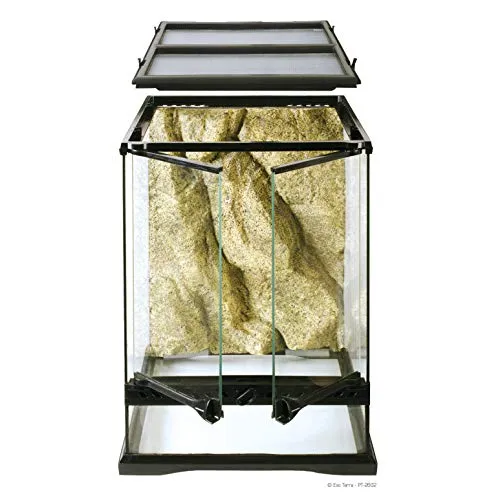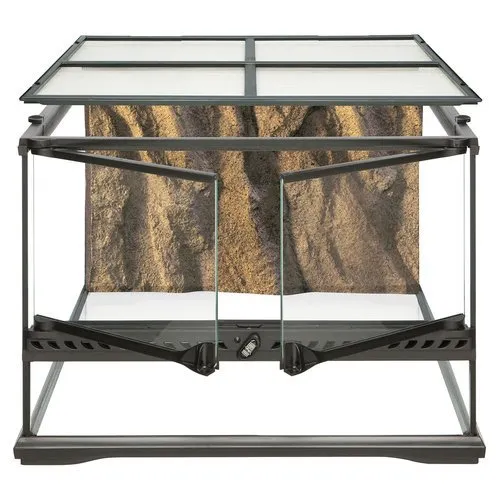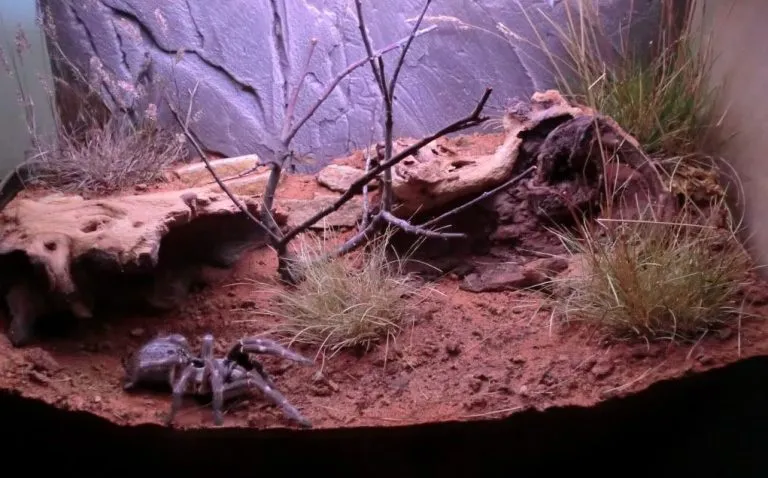What Makes a Great Tarantula Enclosure
Choosing the best tarantula enclosure is crucial for the health, happiness, and longevity of your eight-legged friend. A good enclosure provides a safe, secure, and comfortable environment that mimics the tarantula’s natural habitat. The right enclosure not only facilitates the tarantula’s physical well-being by offering appropriate space, temperature, and humidity, but also supports its behavioral needs, allowing it to thrive and exhibit its natural behaviors. It’s an investment in the well-being of your pet, providing a suitable place to live. A well-chosen enclosure simplifies maintenance, allowing for easier cleaning and monitoring, and offers a visually appealing display. It will also give you the best opportunity to observe and appreciate the unique characteristics of your tarantula. A poor choice, however, can lead to stress, health issues, and even escape, so it is important to choose wisely.
Size Matters Choosing the Right Enclosure
One of the primary considerations when choosing a tarantula enclosure is size. An enclosure that’s too small will restrict your tarantula’s movement, potentially leading to stress and health problems. A good rule of thumb is to provide an enclosure that is at least three times the tarantula’s leg span in width and length. For arboreal species (those that live in trees), the height of the enclosure is also important, as they need space to climb. Juvenile tarantulas should be housed in smaller enclosures initially to make it easier for them to find food and feel secure. As they grow, you’ll need to upgrade to larger enclosures. An enclosure should always have enough room for the tarantula to move around, hunt, and molt comfortably. Don’t be tempted to house a small spider in a large enclosure, as this can sometimes make feeding more difficult, the tarantula might struggle to find its food.
The Best Materials for Tarantula Enclosures

The material of your tarantula enclosure impacts the overall experience of keeping the pet, in terms of visibility, durability, and ease of maintenance. The three most common materials are glass, acrylic, and plastic. Each material has its own advantages and disadvantages that you should consider when making your choice. Transparency is important for viewing your tarantula. Ventilation is crucial for maintaining the correct humidity and preventing mold growth. Accessibility is another factor to consider, the enclosure should have a secure lid that is easy to open for feeding and cleaning. The best material for your tarantula enclosure will depend on your specific needs and preferences, and on the type of tarantula that you own. This decision will dictate much of your caregiving going forward.
Glass Enclosures Pros and Cons
Glass enclosures are a popular choice because they offer excellent visibility, allowing you to observe your tarantula from all angles. Glass is also a durable material that is easy to clean and maintain, it resists scratches and doesn’t cloud over time. However, glass enclosures can be heavier than acrylic or plastic options, making them more difficult to move. They also don’t insulate as well, which can make it harder to maintain a consistent temperature and humidity level, potentially requiring more heating and humidifying equipment. Another potential downside is that glass can break if dropped, and the sharp edges can be a hazard, particularly if the enclosure cracks. Be sure the glass is tempered for safety. Overall, glass enclosures are a good choice for those who value visibility and durability, but be mindful of their weight and insulating properties.
Acrylic Enclosures Pros and Cons
Acrylic enclosures offer many advantages over glass. They are lightweight, making them easy to move and handle. Acrylic is also a better insulator than glass, which can help you maintain a more consistent temperature and humidity. Acrylic is highly transparent, providing a clear view of your tarantula. Another advantage is that acrylic is less likely to break than glass, reducing the risk of injury. However, acrylic can scratch more easily than glass, potentially clouding your view over time. Additionally, some acrylic enclosures may warp or discolor with prolonged exposure to heat or UV light. Acrylic enclosures are a great option for those who want a lightweight, well-insulating, and safe enclosure, but you’ll need to be careful to avoid scratches.
Plastic Enclosures Pros and Cons

Plastic enclosures are often the most affordable option, and they are lightweight and easy to find. They can be very durable, especially those made from high-quality plastics. Plastic enclosures are generally a good insulator, helping to maintain a stable environment for your tarantula. The main disadvantage is that the clarity of the plastic can vary, with some enclosures not being as clear as glass or acrylic. Plastic can also be more prone to scratching and can potentially absorb odors over time. Ventilation can be a key factor, ensuring that the enclosure has sufficient airflow to prevent the buildup of harmful gases and maintain the ideal humidity level. Furthermore, be certain that the plastic is non-toxic and safe for your tarantula. Plastic enclosures are a good choice for budget-conscious keepers who prioritize durability and ease of use, but it is important to choose a high-quality enclosure with good ventilation.
Ventilation Is Key for Tarantulas
Proper ventilation is absolutely essential for maintaining the health and well-being of your tarantula. Adequate airflow prevents the buildup of harmful gases, such as ammonia, and helps to regulate humidity levels. Without proper ventilation, the enclosure can become stagnant, leading to mold growth, bacterial infections, and respiratory problems for your tarantula. Ventilation also plays a role in temperature regulation, helping to dissipate excess heat and prevent overheating. Effective ventilation ensures that the tarantula’s environment remains fresh and clean, contributing to its overall health. The correct setup will depend on the type of enclosure. It is essential to monitor the enclosure regularly to ensure that ventilation is adequate and that the humidity and temperature levels are optimal.
Types of Ventilation Systems
There are several types of ventilation systems commonly used in tarantula enclosures. Cross-ventilation involves vents on opposite sides of the enclosure, allowing air to flow through. This is generally considered the most effective type of ventilation. Top ventilation involves vents in the lid or top of the enclosure. This can be effective, but it’s important to ensure that the ventilation is sufficient to prevent condensation. Side ventilation involves vents located on the sides of the enclosure, below the substrate level. The best choice will depend on the specific needs of your tarantula and the type of enclosure you have. Combinations of these ventilation methods are also common and can provide excellent airflow. Whatever system you choose, the important thing is to make sure it’s appropriate for your species and sized for your enclosure.
Best Ventilation Practices

Several best practices can help you ensure that your tarantula’s enclosure has adequate ventilation. Position the vents strategically to promote good airflow throughout the enclosure. Avoid placing the enclosure in direct sunlight or near heat sources, as this can lead to overheating and dry conditions. Regularly monitor the enclosure for signs of excessive humidity, such as condensation on the walls, and adjust your ventilation practices accordingly. You may need to adjust the ventilation during different seasons or depending on your local climate to maintain the ideal humidity level. Ensure that the vents are properly sized and positioned to prevent escapes. In addition, regular cleaning and maintenance of the enclosure are essential for preventing the build-up of harmful gases and maintaining a healthy environment.
Decorating Your Tarantula’s Home
Decorating your tarantula’s enclosure is more than just an aesthetic choice; it also provides enrichment and security for your pet. A well-decorated enclosure will encourage your tarantula to exhibit its natural behaviors, such as burrowing, hiding, and climbing. The primary elements of decoration include the substrate, hides, and climbing structures. The substrate provides a foundation for the enclosure and is critical for humidity control and burrowing. Hides offer security, allowing your tarantula to retreat from view and feel safe. Climbing structures, such as branches and cork bark, provide vertical space for arboreal species and enrichment for all tarantulas. Avoid using decorations with sharp edges or those that could pose a hazard to your tarantula. It is essential to regularly inspect the decorations and the enclosure, cleaning or replacing any items as needed.
Substrate Recommendations
The substrate, or bedding, is a critical element in a tarantula’s enclosure. It provides a base for the tarantula, helps to regulate humidity, and allows the tarantula to burrow. The best substrate choices vary depending on the species of tarantula, but common options include coco fiber, peat moss, and vermiculite. Coco fiber is a popular choice because it holds moisture well, is readily available, and is relatively inexpensive. Peat moss is another excellent option, but it can be more acidic than coco fiber, so make sure it’s a suitable choice for your tarantula. Vermiculite is another good choice for maintaining humidity, but it doesn’t hold burrows as well as some other substrates. Avoid substrates that are toxic, such as cedar shavings, or that can trap your tarantula’s legs. The substrate should be deep enough to allow burrowing species to construct their tunnels, and it must be kept clean and replaced regularly to prevent mold and bacterial growth.
Hides and Climbing Structures

Hides and climbing structures are essential components of a tarantula enclosure, offering both security and enrichment for your pet. Hides provide a safe place for the tarantula to retreat from view, reducing stress and allowing it to feel secure. Common hide options include cork bark, half logs, and commercially available hides specifically designed for reptiles and arachnids. Climbing structures, such as branches, driftwood, and cork bark, provide opportunities for arboreal tarantulas to climb and explore their environment. Even terrestrial species can benefit from climbing structures, as they can provide a different perspective and enrichment. When choosing hides and climbing structures, consider the size and species of your tarantula, as well as the overall aesthetic of the enclosure. Make sure the items are stable, and non-toxic, with no sharp edges. Providing a variety of options can help create an engaging and stimulating environment for your tarantula.
Where to Buy the Best Tarantula Enclosures
There are several places where you can buy tarantula enclosures, each with its own advantages and disadvantages. The best choice will depend on your individual needs and preferences, as well as your location and budget. Online retailers offer a wide selection of enclosures and accessories, often at competitive prices. Local pet stores can be a good option, providing the opportunity to see the enclosures in person and get advice from experienced staff. Reptile expos are another great place to find enclosures, as they often feature a wide variety of vendors and products. Some hobbyists also build their own enclosures, which can be a rewarding project for those with the skills and resources. Regardless of where you choose to buy your enclosure, always research the retailer and ensure that they offer high-quality products and excellent customer service.
Online Retailers for Tarantula Enclosures
Online retailers offer a vast selection of tarantula enclosures, often at competitive prices. This can be convenient for those who don’t have local options or who prefer to shop from the comfort of their own home. Many online retailers specialize in reptile and arachnid supplies. When buying online, carefully review the product descriptions, specifications, and customer reviews to ensure that you are purchasing the right enclosure for your tarantula. Consider factors such as the material, size, ventilation, and security features. Check the retailer’s return policy and shipping costs before making a purchase. Some popular online retailers include specialty reptile stores, as well as larger online marketplaces. Ordering online provides ease and selection, but you won’t be able to assess the enclosure in person before purchasing it.
Local Pet Stores for Tarantula Enclosures

Local pet stores can be a good option for buying tarantula enclosures, especially if you want to see the enclosure in person before you buy it. Pet stores often have knowledgeable staff who can offer advice and recommendations based on your specific needs. However, the selection of enclosures at local pet stores may be more limited than at online retailers, and prices may be higher. It’s a good idea to call ahead to see if the pet store carries tarantula enclosures before you make a trip. Be sure to ask the staff for their recommendations and for any information about the materials, ventilation, and security features of the enclosures. Support your local pet store, but be sure to do your research, and don’t hesitate to ask questions.
What to Consider When Buying an Enclosure
When choosing a tarantula enclosure, several factors should influence your decision. The size of the enclosure is paramount, ensuring that it is appropriate for your tarantula’s species and size. The material of the enclosure should be durable, easy to clean, and provide good visibility. Ventilation is essential to prevent the build-up of harmful gases and maintain the correct humidity level. The enclosure should have a secure lid to prevent escapes, and it should provide easy access for feeding and cleaning. Consider your budget and how much you are willing to spend on the enclosure. Think about the long-term needs of your tarantula and choose an enclosure that will last. Finally, consider the aesthetic of the enclosure and how it will fit in with your home decor. Choosing wisely will enhance the experience for both you and your tarantula.
Price and Budget
The price of a tarantula enclosure can vary significantly depending on the material, size, and features. Set a budget before you start shopping, and stick to it. Consider the long-term costs, such as the cost of replacement enclosures if the material breaks. Remember that a higher-quality enclosure may be a better investment in the long run, as it is likely to last longer and provide a better environment for your tarantula. Compare prices from different retailers, both online and local, to find the best deal. Don’t be afraid to look for sales and discounts. Be sure to factor in the cost of any accessories you need, such as a substrate, hides, and climbing structures. Prioritizing the well-being of your tarantula is more important than saving a few dollars, so choose an enclosure that provides a safe, secure, and comfortable environment, even if it costs a bit more.
Durability and Longevity

The durability and longevity of a tarantula enclosure are critical factors to consider. Choose an enclosure made from high-quality materials that can withstand the test of time. Glass enclosures are generally durable but can break if dropped. Acrylic enclosures are less likely to break than glass, and they are also resistant to scratches. Plastic enclosures can be very durable, but it is important to choose a high-quality enclosure. Consider the enclosure’s resistance to wear and tear, especially if you have children or other pets. Make sure the enclosure can withstand regular cleaning and maintenance. A well-maintained enclosure should last for many years, providing a safe and secure home for your tarantula. Investing in a durable enclosure will save you money in the long run, as you won’t have to replace it as frequently.
Safety and Security
Safety and security should be top priorities when choosing a tarantula enclosure. The enclosure must be escape-proof, with a secure lid that cannot be easily opened by your tarantula or other pets. Consider the potential hazards of the enclosure’s material. Glass enclosures can shatter, creating sharp edges that could injure your tarantula or yourself. Acrylic and plastic enclosures are less likely to break, but they should be made from non-toxic materials. Ensure that the enclosure is placed in a stable location where it cannot be easily knocked over. If you have children or other pets, make sure the enclosure is in a safe and accessible location. Regularly inspect the enclosure for any signs of damage, such as cracks or loose parts. Always prioritize the safety and security of your tarantula and yourself.
Frequently Asked Questions About Tarantula Enclosures
Here are some of the most frequently asked questions about tarantula enclosures. What is the best size enclosure for my tarantula? The enclosure should be at least three times the tarantula’s leg span in width and length. What is the best material for a tarantula enclosure? The best material depends on your needs, but glass, acrylic, and plastic are all good options. How important is ventilation? Ventilation is essential for maintaining the health and well-being of your tarantula. How often should I clean my tarantula enclosure? Clean the enclosure regularly, typically every 1-3 months, depending on the size and species of your tarantula. Where can I buy a tarantula enclosure? You can buy tarantula enclosures online, at local pet stores, or at reptile expos. Always research the retailer and ensure they offer high-quality products. By answering these questions and following the guidelines, you can select the ideal enclosure and keep your tarantula safe and healthy.
